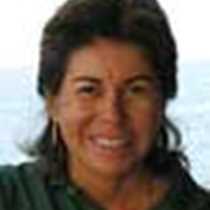Santa Cruz and North Seymour Islands
Our expedition through the Galápagos continued along the north-western coast of Santa Cruz Island. We dropped anchor off a visitor site named “Cerro Dragon,” which literally translates as Dragon Hill and was opened to tourism on August 31st, 1995.
We spilt into two groups, with some of us electing to take a hike around the hill while others took a more relaxing but just as rewarding option to cruise around some small offshore islets in our Zodiacs.
The hike skirted a small salt water lagoon before proceeding through a Palo Santo forest and around the hill itself; and over its duration we found three flamingos, two black-necked common stilts, a couple of medium ground finches along with yellow warblers, mockingbirds and a dozen land iguanas.
The colour of the ocean in the area was absolutely beautiful, the coralline bottom and the strong sunlight giving rise to the brilliant turquoise colouration. Zodiac cruisers spied dozens of sharks and rays in the shallow waters bathing the mangrove-lined canals, as well as many herons and other shore birds.
Once back on board, we swam in the cool Pacific waters off the ship to freshen up, then the Islander lifted anchor to set off towards our afternoon destination, the islet of North Seymour. En route we passed by and circumnavigated a tuff cone named Daphne Major, a famous spot immortalized by a couple of British scientists named Peter and Rosemary Grant. They started their long-term research into natural selection among finches in the early 70’s, a fascinating story recounted in the Pulitzer Prize winner “The Beak of the Finch” (by Jonathan Weiner). During this time, we not only learned about the story, but simultaneously observed Nazca boobies, sea lions and red-billed tropicbirds.
North Seymour, along with Baltra and Mosquera Islets, are actually fragments of ocean bottom that uplifted along a fault line. It reaches a total altitude of just 25 meters (90 feet) and harbours large mixed colonies of two species of frigate birds (the magnificent and the great) and blue-footed boobies. We started our afternoon activities with a snorkel option, during which we had the opportunity to swim with both endemic fur sea lions and Galápagos sea lions. We also found a large school of yellow-tailed surgeonfish, and several brightly-coloured parrot fish. The sunset walk among the inhabitants of this highly populated islet was one that we will remember for many years to come.
Our expedition through the Galápagos continued along the north-western coast of Santa Cruz Island. We dropped anchor off a visitor site named “Cerro Dragon,” which literally translates as Dragon Hill and was opened to tourism on August 31st, 1995.
We spilt into two groups, with some of us electing to take a hike around the hill while others took a more relaxing but just as rewarding option to cruise around some small offshore islets in our Zodiacs.
The hike skirted a small salt water lagoon before proceeding through a Palo Santo forest and around the hill itself; and over its duration we found three flamingos, two black-necked common stilts, a couple of medium ground finches along with yellow warblers, mockingbirds and a dozen land iguanas.
The colour of the ocean in the area was absolutely beautiful, the coralline bottom and the strong sunlight giving rise to the brilliant turquoise colouration. Zodiac cruisers spied dozens of sharks and rays in the shallow waters bathing the mangrove-lined canals, as well as many herons and other shore birds.
Once back on board, we swam in the cool Pacific waters off the ship to freshen up, then the Islander lifted anchor to set off towards our afternoon destination, the islet of North Seymour. En route we passed by and circumnavigated a tuff cone named Daphne Major, a famous spot immortalized by a couple of British scientists named Peter and Rosemary Grant. They started their long-term research into natural selection among finches in the early 70’s, a fascinating story recounted in the Pulitzer Prize winner “The Beak of the Finch” (by Jonathan Weiner). During this time, we not only learned about the story, but simultaneously observed Nazca boobies, sea lions and red-billed tropicbirds.
North Seymour, along with Baltra and Mosquera Islets, are actually fragments of ocean bottom that uplifted along a fault line. It reaches a total altitude of just 25 meters (90 feet) and harbours large mixed colonies of two species of frigate birds (the magnificent and the great) and blue-footed boobies. We started our afternoon activities with a snorkel option, during which we had the opportunity to swim with both endemic fur sea lions and Galápagos sea lions. We also found a large school of yellow-tailed surgeonfish, and several brightly-coloured parrot fish. The sunset walk among the inhabitants of this highly populated islet was one that we will remember for many years to come.




